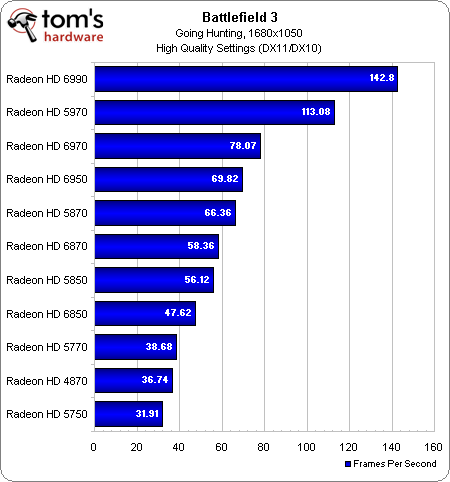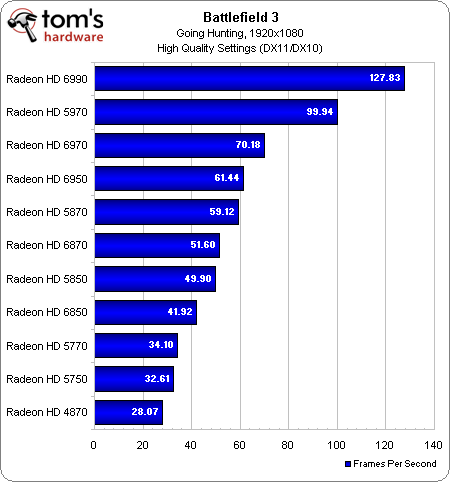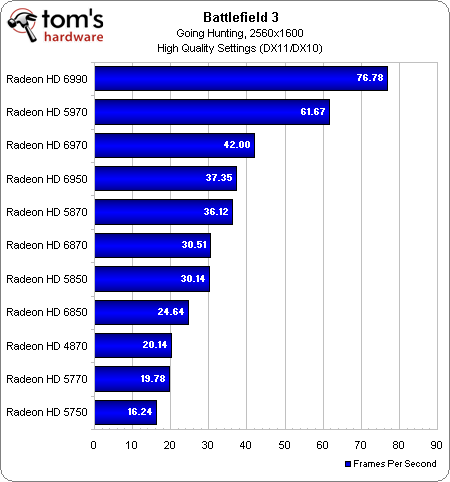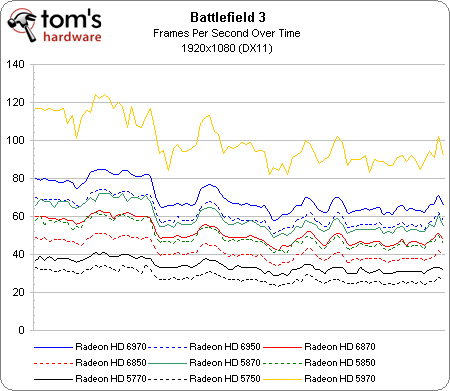Battlefield 3 Performance: 30+ Graphics Cards, Benchmarked
Are you wondering how your PC will handle Battlefield 3 before buying the game? We pulled a series of all-nighters to get almost every graphics card in our lab tested, in addition to a handful of processors, to answer your performance-oriented questions.
Benchmark Results: AMD Graphics Cards, High Quality
Overcoming Teething Pains
Despite my searching, I could find no evidence that Battlefield 3 is one of Nvidia’s “The Way It’s Meant To Be Played”-sponsored games (even though the studio had a strong presence at GeForce LAN 6). As a result, I was a little surprised to encounter so many problems getting AMD-based multi-GPU configurations working.
At first, the Radeon HD 6990 wouldn’t run at all with the Catalyst 11.10 Preview 3 driver installed, locking up before I could complete any benchmark run (and on the only two boards in my collection). The Radeon HD 5970 worked, but dropped a GPU after every resolution change, requiring a game restart. A subsequent install cratered the 5970 altogether, preventing us from generating anti-aliasing scores with it. None of our two-board setups functioned at all.
Then, I spent a full day trying to drum up answers. Replacing cards, power supplies, switching motherboard slots, swapping SSDs, reformatting SSDs, installing beta Application Profiles…none of it helped. On a whim, I pulled the 16 GB (2 x 8 GB) Crucial DDR3-1333 memory kit I used for my Bulldozer review and replaced it with 8 GB of G.Skill modules. Suddenly, I could run benchmarks. They’d still crash when I changed resolutions. But I could generate results, at least.
I asked AMD what interaction CrossFire had with system memory that wasn't part of a single-card config and would cause a system memory compatibility problem, but didn't get an answer. The company did, however, confirm that it's seeing the same CrossFire-based issues in its own lab.
In this particular sequence, AMD’s Radeon HD 6990 performs exceptionally, smoking right past what we saw the GeForce GTX 590 do. It’s only a shame, then, that the 6990 and 5970 behind it are currently so unusable.
At 1680x1050, the more than two-year-old Radeon HD 5850 is a solid bet, trumping the more modern Radeon HD 6850. That’s not to say you couldn’t get playable performance out of lesser cards like the Radeon HD 5770 or 4870. You’d simply need to dial down the visuals to get there.
Get Tom's Hardware's best news and in-depth reviews, straight to your inbox.
Maintaining High quality at 1920x1080 is still possible with a Radeon HD 5850, though you’d probably be better-served by a 5870 or Radeon HD 6900-series board.
Meanwhile, even a Radeon HD 6970 is going to have a hard time keeping up at 2560x1600. Really, it takes a dual-GPU solution to push the big frame rates at that resolution. Frankly, the same thing applies to Nvidia's line-up, though. In fact, the Radeon HD 6970 achieves a better result at 2560x1600 (and the other two resolutions) than the GeForce GTX 580!
Current page: Benchmark Results: AMD Graphics Cards, High Quality
Prev Page Benchmark Results: Nvidia Graphics Cards, What Do I Need For Ultra Quality? Next Page Benchmark Results: AMD Graphics Cards, Low Quality-
great review. but I am curious if a gtx 560ti can run ultra on a playable fps? because I am about to buy one :DReply
-
orellius nevermind my comment about 560 Ti, I see it in the benchmarks (high) but it is not on the main page list of cards (missed putting it there?) (yes, I used the search feature in my browser, no 560 to speak of)Reply -
m0th2 sirus3020great review. but I am curious if a gtx 560ti can run ultra on a playable fps? because I am about to buy oneReply
Without any form of AA you can run it on ultra and get over 30fps on every map @ 1920x1080 easily (over 60 when close quarters). Depends on your cpu and if you OC your gpu though. i have mine at 940/2100 and its always above 40fps. -
kcorp2003 AWESOME! thank you very much for this. looks like i wont have to upgrade my CPU then. i have HD4870 and i play this on medium settings but still i want the ultra settings. :)Reply -
aznshinobi Great read, lovely to see a wide assortment tested, specially my 5850. Thanks for taking the time Chris, I'm sure it must've taken FOREVER to bench and swap all those cards.Reply




